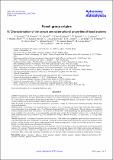Files in this item
Fossil group origins IV. Characterization of the sample and observational properties of fossil systems
Item metadata
| dc.contributor.author | Zarattini, S. | |
| dc.contributor.author | Barrena, R. | |
| dc.contributor.author | Girardi, M. | |
| dc.contributor.author | Castro-Rodriguez, N. | |
| dc.contributor.author | Boschin, W. | |
| dc.contributor.author | Aguerri, J.A.L. | |
| dc.contributor.author | Mendez Abreu, Jairo | |
| dc.contributor.author | Sánchez-Janssen, R. | |
| dc.contributor.author | Catalán-Torrecilla, C. | |
| dc.contributor.author | Corsini, E.M. | |
| dc.contributor.author | Del Burgo, C. | |
| dc.contributor.author | D'Onghia, E. | |
| dc.contributor.author | Herrera-Ruiz, N. | |
| dc.contributor.author | Iglesias-Páramo, J. | |
| dc.contributor.author | Bailon, E.J. | |
| dc.contributor.author | Muoz, M.L. | |
| dc.contributor.author | Napolitano, N. | |
| dc.contributor.author | Vilchez, J.M. | |
| dc.date.accessioned | 2014-08-28T09:31:03Z | |
| dc.date.available | 2014-08-28T09:31:03Z | |
| dc.date.issued | 2014-05-21 | |
| dc.identifier | 143968600 | |
| dc.identifier | cde22445-32a0-468d-885e-143c39d38fa1 | |
| dc.identifier | 84901263763 | |
| dc.identifier | 000336730900116 | |
| dc.identifier.citation | Zarattini , S , Barrena , R , Girardi , M , Castro-Rodriguez , N , Boschin , W , Aguerri , J A L , Mendez Abreu , J , Sánchez-Janssen , R , Catalán-Torrecilla , C , Corsini , E M , Del Burgo , C , D'Onghia , E , Herrera-Ruiz , N , Iglesias-Páramo , J , Bailon , E J , Muoz , M L , Napolitano , N & Vilchez , J M 2014 , ' Fossil group origins IV. Characterization of the sample and observational properties of fossil systems ' , Astronomy & Astrophysics , vol. 565 , A116 . https://doi.org/10.1051/0004-6361/201323351 | en |
| dc.identifier.issn | 0004-6361 | |
| dc.identifier.uri | https://hdl.handle.net/10023/5272 | |
| dc.description | This work was partially funded by the Spanish MICINN (grant AYA2010-21887-C04-04), and the local Canarian Government (grant ProID20100140). E.D. gratefully acknowledges support from the Alfred P. Sloan Foundation. M.G. acknowledges financial support from the MIUR PRIN/2010−2011 (J91J12000450001). E.M.C. is supported by Padua University (grants 60A02-1283/10,5052/11, 4807/12). J.I.P. and J.V.M. acknowledge financial support from the Spanish MINECO under grant AYA2010-21887-C04-01, and from Junta de Andalucía Excellence Project PEX2011-FQM7058. J.M.A. acknowledges support from the European Research Council Starting Grant (SEDmorph; P.I. V. Wild). | en |
| dc.description.abstract | Context. Virialized halos grow by the accretion of smaller ones in the cold dark matter scenario. The rate of accretion depends on the different properties of the host halo. Those halos for which this accretion rate was very fast and efficient resulted in systems dominated by a central galaxy surrounded by smaller galaxies that were at least two magnitudes fainter. These galaxy systems are called fossil systems, and they can be the fossil relics of ancient galaxy structures. Aims. We started an extensive observational program to characterize a sample of 34 fossil group candidates spanning a broad range of physical properties. Methods. Deep r-band images were obtained with the 2.5-m Isaac Newton Telescope and Nordic Optic Telescope. Optical spectroscopic observations were performed at the 3.5-m Telescopio Nazionale Galileo for ~1200 galaxies. This new dataset was completed with Sloan Digital Sky Survey Data Release 7 archival data to obtain robust cluster membership and global properties of each fossil group candidate. For each system, we recomputed the magnitude gaps between the two brightest galaxies (Δm12) and the first and fourth ranked galaxies (Δm14) within 0.5 R200. We consider fossil systems to be those with Δm12 ≥ 2 mag14 or Δm ≥ 2.5 mag within the errors. Results. We find that 15 candidates turned out to be fossil systems. Their observational properties agree with those of non-fossil systems. Both follow the same correlations, but the fossil systems are always extreme cases. In particular, they host the brightest central galaxies, and the fraction of total galaxy light enclosed in the brightest group galaxy is larger in fossil than in non-fossil systems. Finally, we confirm the existence of genuine fossil clusters. Conclusions. Combining our results with others in the literature, we favor the merging scenario in which fossil systems formed from mergers of L* galaxies. The large magnitude gap is a consequence of the extreme merger ratio within fossil systems and therefore it is an evolutionary effect. Moreover, we suggest that at least one fossil group candidate in our sample could represent a transitional fossil stage. This system could have been a fossil in the past, but not now owing to the recent accretion of another group of galaxies. | |
| dc.format.extent | 13 | |
| dc.format.extent | 1074181 | |
| dc.language.iso | eng | |
| dc.relation.ispartof | Astronomy & Astrophysics | en |
| dc.subject | Galaxies: formation | en |
| dc.subject | Galaxies: groups: general | en |
| dc.subject | Galaxies: clusters: general | en |
| dc.subject | Galaxies: elliptical and lenticular, cD | en |
| dc.subject | Galaxies: evolution | en |
| dc.subject | Galaxies: distances and redshifts | en |
| dc.subject | QB Astronomy | en |
| dc.subject.lcc | QB | en |
| dc.title | Fossil group origins IV. Characterization of the sample and observational properties of fossil systems | en |
| dc.type | Journal article | en |
| dc.contributor.sponsor | European Research Council | en |
| dc.contributor.institution | University of St Andrews. School of Physics and Astronomy | en |
| dc.identifier.doi | 10.1051/0004-6361/201323351 | |
| dc.description.status | Peer reviewed | en |
| dc.identifier.url | http://www.scopus.com/inward/record.url?eid=2-s2.0-84901263763&partnerID=8YFLogxK | en |
| dc.identifier.grantnumber | ERC-2012-StG-20111012 | en |
This item appears in the following Collection(s)
Items in the St Andrews Research Repository are protected by copyright, with all rights reserved, unless otherwise indicated.

